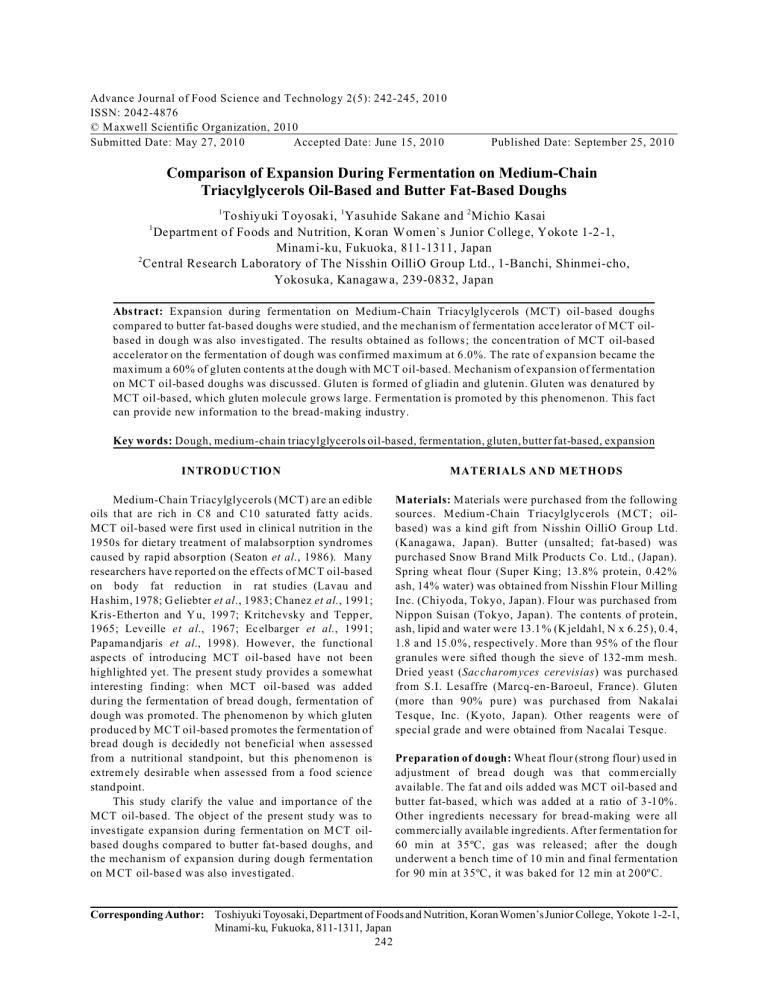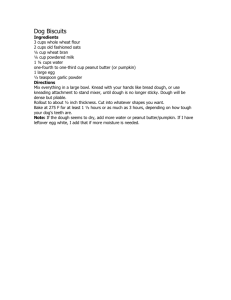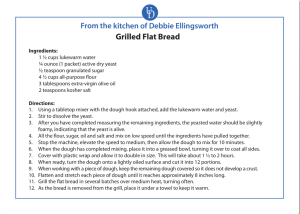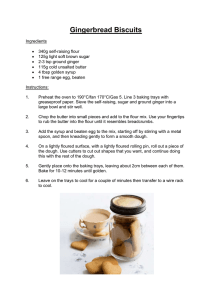Advance Journal of Food Science and Technology 2(5): 242-245, 2010
advertisement

Advance Journal of Food Science and Technology 2(5): 242-245, 2010 ISSN: 2042-4876 © M axwell Scientific Organization, 2010 Submitted Date: May 27, 2010 Accepted Date: June 15, 2010 Published Date: September 25, 2010 Comparison of Expansion During Fermentation on Medium-Chain Triacylglycerols Oil-Based and Butter Fat-Based Doughs 1 Toshiyuki T oyosak i, 1 Yasuhide Sakane and 2 Michio Kasai Departm ent of Foods and Nutrition, K oran Women`s Junior College, Yoko te 1-2-1, Minami-ku, Fukuoka, 811-1311, Japan 2 Central Research Laboratory of The Nisshin OilliO Group Ltd., 1-Banchi, Shinmei-cho, Yokosuka, Kanagaw a, 239-0832, Japan 1 Abstract: Expansion during fermentation on Medium-Chain Triacylglycerols (MCT) oil-based doughs compared to butter fat-based doughs were studied, and the mechan ism of fermentation accelerator of MCT oilbased in dou gh w as also investigated. The results obtained as follows; the concen tration of MCT oil-based accelerator on the fermentation of dough was confirmed maximum at 6.0%. The rate of expansion became the maximum a 60% of gluten contents at the dough with MC T oil-based. Mechanism of expansion of fermentation on MC T oil-based doughs was discussed. Gluten is formed of gliadin and glutenin. Gluten was denatured by MCT oil-based, which gluten molecule grows large. Fermentation is promoted by this phenomenon. This fact can provide new information to the bread-making industry. Key words: Dough, medium-chain triacylglycerols oil-based, fermentation, gluten, butter fat-based, expansion INTRODUCTION MATERIALS AND METHODS Medium-Chain Triacylglycerols (MCT) are an edible oils that are rich in C8 and C10 saturated fatty acids. MCT oil-based were first used in clinical nutrition in the 1950s for dietary treatment of malabsorption syndromes caused by rapid absorption (Seaton et al., 1986). Many researchers have reported on the effects of MC T oil-based on body fat reduction in rat studies (Lavau and Hashim, 1978; G eliebter et al., 1983; Chanez et al., 1991; Kris-Etherton and Y u, 199 7; Kritchevsky an d Tepp er, 1965; Leveille et al., 1967; Ecelbarger et al., 1991; Papama ndjaris et al., 1998). However, the functional aspects of introducing MCT oil-based have not been highlighted yet. The present study provides a somewhat interesting finding: when MCT oil-based was added during the fermentation of bread dough, fermentation of dough was promoted. The phenomenon by which gluten produced by MC T oil-based promotes the fermentation of bread dough is decidedly not beneficial when assessed from a nutrition al stand point, but this phenom enon is extrem ely desirable when assessed from a food science standpoint. This study clarify the value and im portan ce of the MCT oil-based. The object of the present study was to investigate expansion during fermentation on M CT oilbased doughs compared to butter fat-based doughs, and the mechanism of expansion during dough fermentation on M CT oil-base d was also investigated. M aterials: Materials were purchased from the following sources. Medium -Chain Triacylglycerols (M CT ; oilbased) was a kind gift from Nisshin OilliO Group Ltd. (Kanagawa, Japan). Butter (unsalted; fat-based) was purchased Snow B rand Milk Products Co. Ltd., (Japan). Spring wheat flour (Super King; 13.8% protein, 0.42% ash, 14% water) was obtained from Nisshin Flour Milling Inc. (Chiyoda, Tokyo, Japan). Flour was purchased from Nippon Suisan (Tokyo, Japan). The contents of protein, ash, lipid and water we re 13.1 % (K jeldahl, N x 6.25), 0.4, 1.8 and 15.0%, respectively. More than 95% of the flour granules were sifted though the sieve of 132-mm mesh. Dried yeast (Saccharom yces cerevisias) was purchased from S.I. Lesaffre (Marcq-en-Baroeul, France). Gluten (more than 90% pure) was purchased from Nakalai Tesque, Inc. (Kyoto, Japan). Other reagents were of special grade and were obtained from Nacalai Tesque. Preparation of dough: Wheat flour (strong flour) used in adjustment of bread dough was that co mm ercially available. The fat and oils added was MCT oil-based and butter fat-based, w hich was added at a ratio of 3-10%. Other ingredients necessary for brea d-making were all commercially available ingredients. After fermentation for 60 min at 35ºC, gas was released; after the dough underwent a bench time of 10 min and final fermentation for 90 min at 35ºC, it was baked for 12 min at 200ºC. Corresponding Author: Toshiyuki Toyosaki, Department of Foods and Nutrition, Koran Women’s Junior College, Yokote 1-2-1, Minami-ku, Fukuoka, 811-1311, Japan 242 Adv. J. Food Sci. Technol., 2(5): 242-245, 2010 Determination of wet gluten content in dough: Wet gluten extracts in dough was in accordance with the method of Ribotta et al. (2005) with some modifications. The crude wet gluten was extracted with 0.005 N lactic acid for 1 h, the mixture w as adjusted to pH 4.7 (85% lactic acid) and stirred for 5h. The suspension was centrifuged at 1,600xg for 15 min at 20ºC to remove the insoluble fraction. Measurement of the rate of dough expansion: For the rate of dough expansion with fermentation, a fixed amount of dough was placed in a graduated cylinder and fermented in an incubator (temperature 30ºC, humidity 75%) and the rate of expansion in a fixed time was measured. Measurement of the amount of protein: The amount of protein was m easured b y the Low ry et al. (1951) method. SDS-polyacrylamide gel electroph oresis (PA GE ): Measurement was in accordance with the method of Laemmli (1979). Electrophoresis was performed using the Mini-Protean II Electrophoresis Cell (Bio-R ad Laboratories, Inc., Japan) at 18mA/gel with Ready Gel J of differing gel concentrations. After electrophoresis, gels were stained using C ooma ssie brilliant blue-R250 . In addition, automated electrophoresis (Phast System; Pharmacia LKB, Biotechnology AB, Uppsala, Sweden) equipment was used. Fig. 1: Changes in the rate of expansion with the fermentation of dough with MCT and butter during storage for 40 min at 37ºC. Each value represents the mean ± SD in triplicate Statistical analysis: Data were reported as mean±SD. Analysis of variance and least significant difference tests were cond ucted to identify differences among means. Statistical significance was declared at p<0.05. RESULTS AND DISCUSSION Changes in the rate of expansion of dough: The contents of lipid by MCT oil-based induction increased as fermentation time progressed. However, the amount of butter produced in butter dough tended not to increase for the most part. Results of measuring the percent rate of expansion at that time are shown in Fig. 1. Dough with MCT oil-based expanded rapidly after the start of fermentation for up to 35 min. but later expansion tended to decrease abruptly. In contrast, butter fat-based dough reached its maximum rate of expansion 25 min. from the start of fermentation and this tended to decrease gradu ally afterwards. In addition, changes in the rate of expansion in unit time were smaller than those in dou gh w ith MCT oil-based. Changes brought about by this phenomenon are quite likely to b e som e effect that gluten produced by MC T oil-based has in the fermentation stage. Fig. 2: Effect of lipid contents on the rate of expansion of dough with MCT and butter during storage for 40 min at 37ºC. Each value represents the mean ± SD in triplicate this experiment also studied the effects of the lipids contents added. W hen dough w ith various lipids contents, as shown in Fig. 2, with up to 6.0% MC T oil-based both had rates of expa nsion that tended to inc rease with fermentation time, but there were almost no changes in Effects of lipids during fermentation: The amount of fat and oils added influences the fermentation of dough, so 243 Adv. J. Food Sci. Technol., 2(5): 242-245, 2010 MCT Butter Fig. 4: Changes in the molecular weight of gluten in the fermentation of dough for 50 min fermentation using affinity chrom atogra phy, and ultimately the gluten fraction was obtained. This gluten fraction was subjected to SDS-gel electrophoresis. These results are shown in Fig. 4. With MCT oil-based dough, almost no changes were found in the molecular weight of gluten in a fermentation time of 50 min. In contrast, in dough with b utter changes in the molecular weight of gluten did appear with fermentation, and formation of gluten polym ers w ith fermentation was found. This phenomenon is the MC T oil-based produced acting on gluten, which may ind uce d enatu ration. Fig. 3: Effect of gluten content on the rate of expansion of dough. Each value represents the mean ± SD in triplicate the percent rate of expansion at 8.0% and above and instead they tended to decrease. However, the rate of expansion of dough with butter tended to increase more than the rate of that MCT oil-based. Detailed study of the relationship between protein aggregation and MCT oilbased produced was not done, so further study is needed in the future. The mecha nism by w hich M CT oil-based acts to prom ote fermentation: The various experimental results obtained this far were analyzed comprehensively, and the mechanism of action by which M CT oil-base d acts to prom ote fermentation is shown in Fig. 5. In gluten formation, gluten is formed by gliadin and g lutelin forming a network structure. Crosslinking gluten in the presence of MCT oil-based, the molecules themselves form macromolecules. As a result, expansion is promoted by the uptake of large amounts of carbon dioxide gas produced during the ferm entation of do ugh. This phenomenon ultimately serves as an advantage when baking dough and improves the bread’s texture. Effects of gluten contents during fermentation: Next, whether a difference in gluten content is involved in the fermentation of dough with M CT oil-base d and butter fatbased was studied. These results are shown in Fig. 3. Expansion of dough began at gluten content of 40%, and the rate of expansion reached its maximum at gluten content of a concentration of 60%. Afterwards, the rate of expansion tended to decrease gradually. Dough with MCT oil-based had a rate of expansion of about 74% at a gluten content of 60% , while butter dough had a rate of 22%, so the presence or absence of MCT oil-based has an effect on the rate of expansion. This is the MCT oil-based produced acting to promote fermentation. CONCLUSION The curren t researc h dem onstrated that wellfermented dough can be produced by the induction of MCT oil-based when fermenting dough. The induction of MCT oil-based was achieved in the current study by fatbased (butter) induction, but a similar p henome non shou ld also occur with MC T oil-based induced by other methods. This phenomenon is advantageous when baking bread and can be used to enhance the quality of baked bread. Based on the results of these tests of physical properties, further detailed study is needed of the effect of MCT oil-based on the flavor of baked bread. Relationship between lipids and gluten: 6.0% MCT oilbased and butter fat-based 8.0% contents involved in the fermentation of dough in a facilitory manner, and the rate of dough ex pansion increases as a result. This phenomenon consequently acts in a positive manner when dough is baked. To study what effect lipids produced during the fermentation of dough has on gluten, gluten was separated and purified after the completion of 244 Adv. J. Food Sci. Technol., 2(5): 242-245, 2010 Fig. 5: The mechanism of the fermentation accelerator of MCT Laemm li, U.K., 1979. Cleavage of structural proteins during the assemb ly of the head of bacteriophage T4. Nature, 227: 680-685. Leveilie, G.A ., R.S. P ardini and J.A. Tillotson, 1967. Influence of medium -chain Triacylglycerols on lipid metabolism in the rats. Lipids, 2(4): 287-294. Lowly, O.H., N.J. Rosebrough, A .L. Farr and R.J. Randall, 1951. Pro tein measu rement with the Folin phenol reagent. J. Biol. C hem ., 193(1 ): 263-2 75. Papamand jaris, A.A., D.E. Macdougall and P.J.H. Jones, 1998. Medium chain fatty acid metabolism and energy expenditure: obesity treatment implications. Life Sci., 62(14): 1203-1215. Ribotta, P.D., A.E. Leòn, G.T. Pérewz and M.C. Anòn, 2005. Electrophoresis studies for determining wheatsoy protein interactions in dough and bread . Eur. Food Res. Technol., 221(1-2): 48-53. Seaton, T.B., S.L. Welle, M.K. W arenk and R.G . Campbell, 1986. Thermic effect of mediumchain and long-chain triacylglycerols in man. Am. J. Clin. Nutr., 44: 630-634. REFERENCES Chanez, M., B. Bois-Joyeux, M.J. Arnaud and J. Peret, 1991. Metabolic effects in rats of a diet with a mod erate level of medium-chain triacylglycerols. J. Nutr., 121(5): 585-594. Ece lbarger, G.L ., J.B. Lasekan an d D.M. Ney , 1991 . In vivo triglycerid e secretion and hepatic and plasma lipids in rats fed medium-chain triacylglycerols, tripelargonin, or corn o il. J. Nutr. Biochem ., 2: 260-266. Geliebter, A., N. Torbay, E.F. Bracco, S.A. Hashim and T.B. Van Italie, 19 83. O verfee ding w ith mediumchain triglyceride diet results in diminished deposition of fat. Am. J. C lin. Nu tr., 37(1): 1-4. Kris-Etherton, P.M . and S . Yu, 1997 . Individual fatty a cid effects on plasma lipids and lipoproteins: human studies. Am . J. Clin. N utr., 65: 1628S-1644S. Kritchevsky, D. and S.A. Tepper, 1965. Influence of medium-chain triglyceride (MCT) on cholesterol metabolism in rats. J. Nutr., 86(1): 67-72. Lavau, M.M. and S .A. H ashim , 1978 . Effect of medium chain triglycerid e on lipogenesis and b ody fat in the rat. J. Nu tr., 108(4): 613-620. 245





